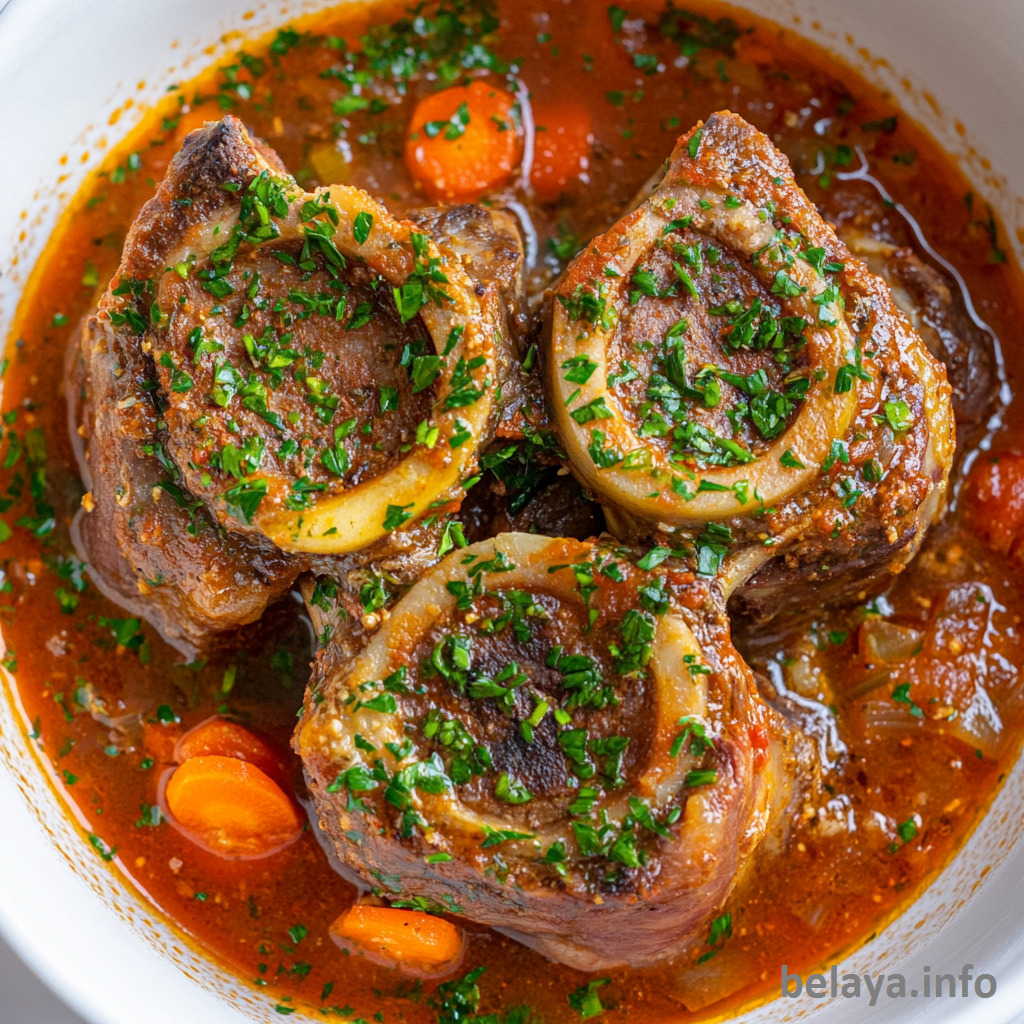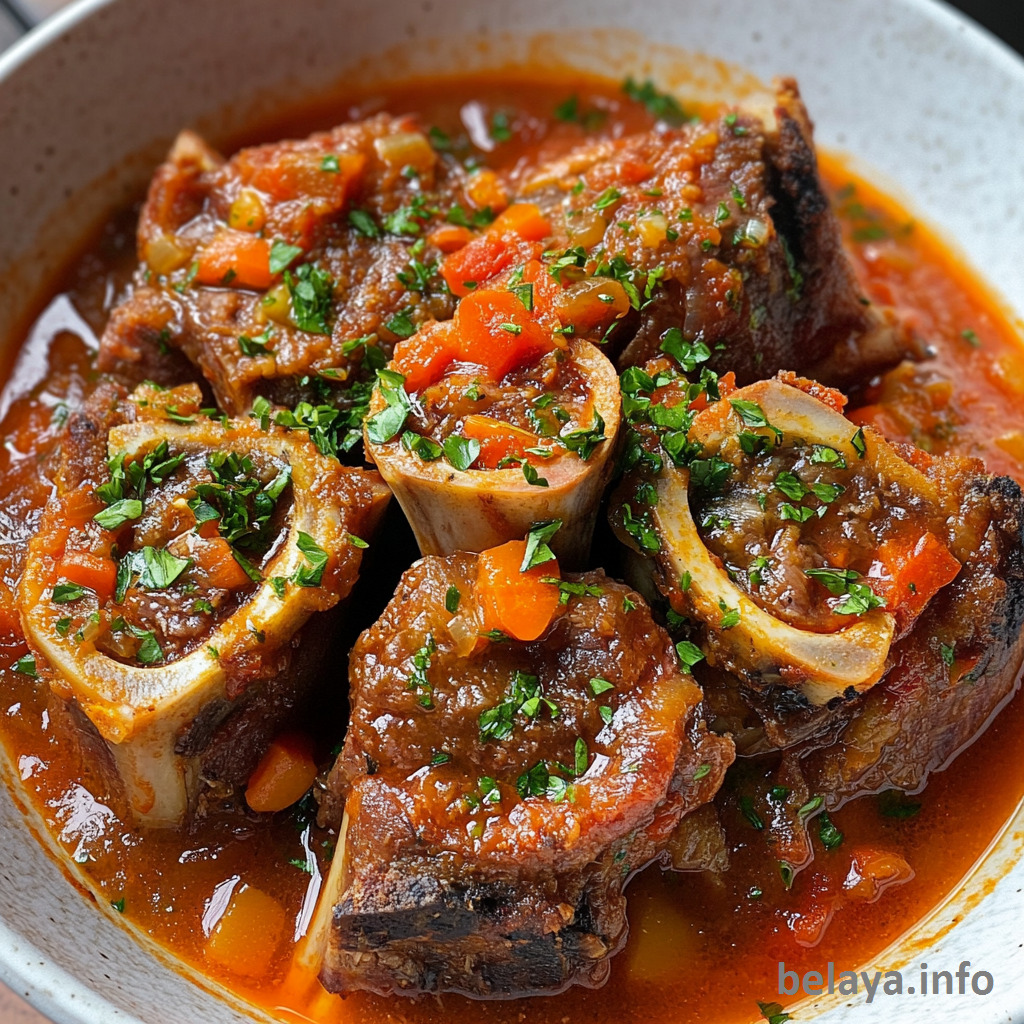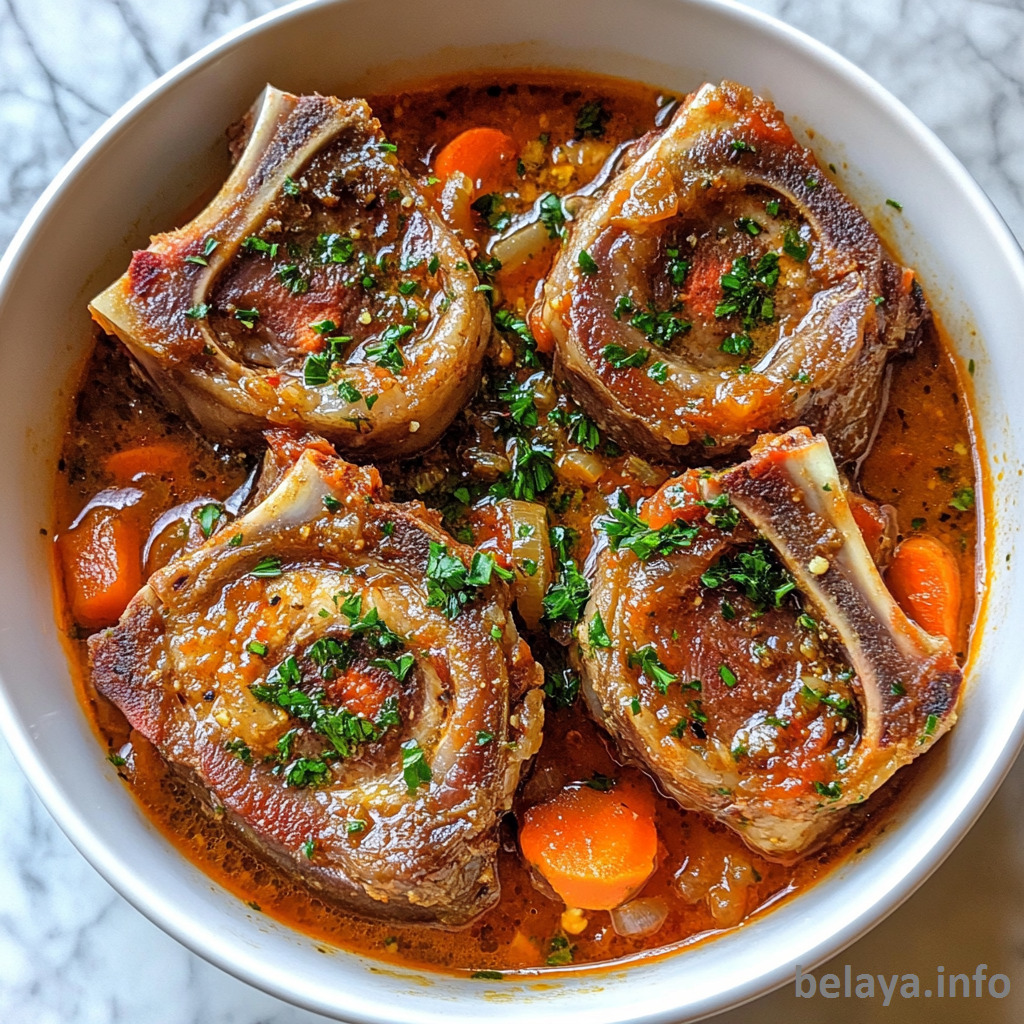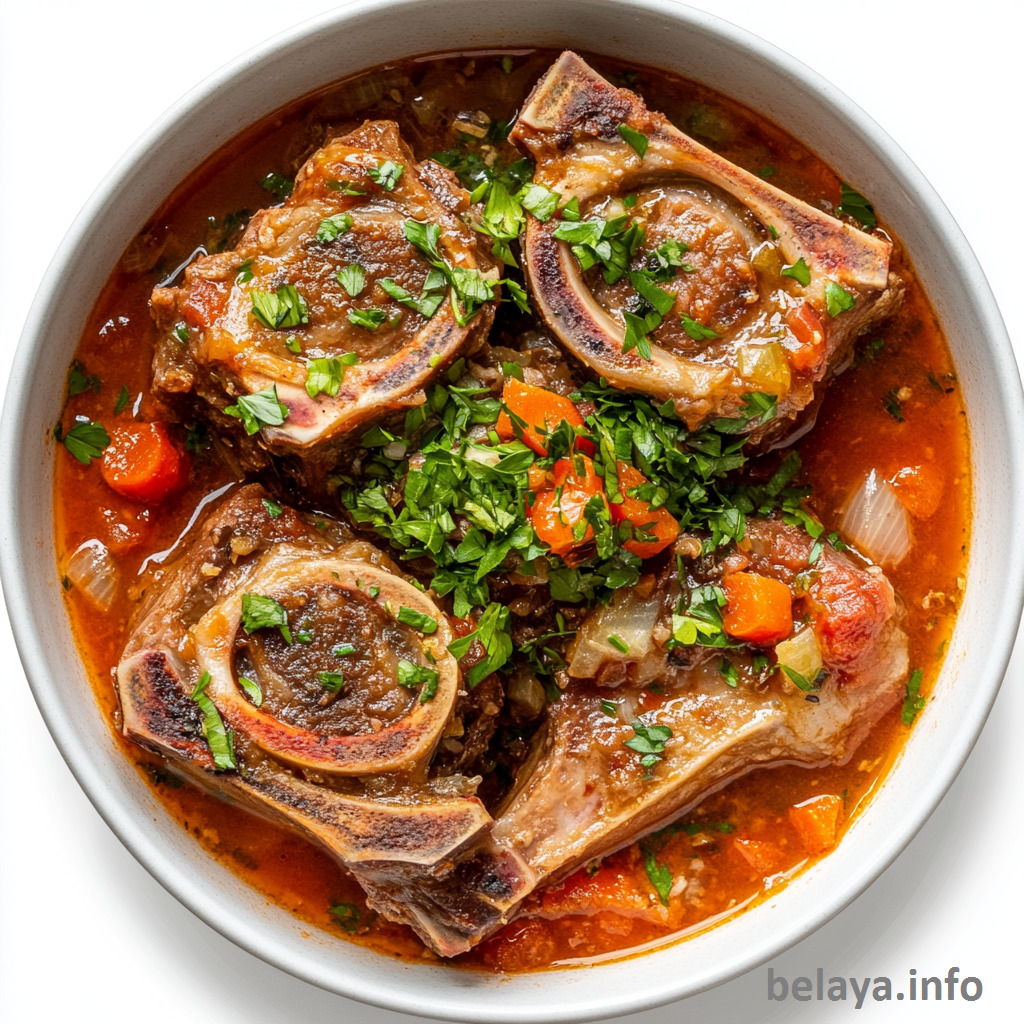Italian Osso Buco
Osso Buco is a traditional Italian dish renowned for its tender veal shanks braised to perfection in a rich, flavorful sauce. This recipe showcases cross-cut veal shanks with marrow, simmered gently in a blend of white wine, broth, and aromatic seasonings.
The dish is elevated with a vibrant gremolata—a zesty mix of parsley, garlic, and lemon zest—that adds a refreshing contrast to the hearty flavors of the osso buco.
Perfectly suited for a special occasion or a comforting meal, this dish promises a taste of Italian culinary heritage, balanced with tender meat and a savory, aromatic sauce.

Why You’ll Love This Recipe:
Tender, Flavorful Meat: The veal shanks cook slowly and become incredibly tender, with the marrow in the bone adding richness and depth to the sauce. The long braising process ensures the meat absorbs all the delicious flavors of the broth and aromatics.
Classic Italian Comfort: This dish is a staple of Italian cuisine, particularly from Milan, offering a comforting, rustic flavor that’s perfect for a special meal. It’s a dish that feels both elegant and homey, making it ideal for family gatherings or a dinner party.
Balanced, Rich Sauce: The slow-cooked broth, enhanced with wine, tomato paste, and the natural juices from the veal, creates a rich, creamy sauce. The result is a mouthwatering combination of savory, umami flavors that pair beautifully with the tender meat.
Fresh Gremolata Topping: The gremolata—a zesty blend of parsley, garlic, and lemon zest—adds a fresh, bright contrast to the richness of the osso buco. It lifts the dish with a burst of freshness that balances the deep, savory flavors of the meat and sauce.
Impressive Yet Simple: Though osso buco looks and tastes impressive, it’s surprisingly simple to make with just a few steps. The dish is perfect for showcasing your cooking skills without requiring complex techniques, making it ideal for both beginner and experienced cooks.
Perfectly Paired Sides: Osso buco is often served with creamy polenta, risotto, or crusty bread, making it a complete and satisfying meal. The sauce is perfect for soaking into these sides, making every bite even more delicious.
Versatile and Memorable: The combination of tender meat, rich broth, and the bright gremolata makes this dish unforgettable. It’s a dish that can be enjoyed for a variety of occasions, from a cozy dinner to a festive gathering.

Key Ingredients:
Veal Osso Buco: The star of the dish, veal shanks, are braised to perfection, with the marrow in the bone adding richness and flavor to the sauce.
Butter & Olive Oil: A combination of butter and extra virgin olive oil is used to sauté the onions and brown the veal, providing a rich base for the dish.
Onion: Finely chopped onion is cooked slowly to create a sweet and aromatic foundation for the braising liquid.
White Wine: Dry white wine is added to deglaze the pan and enhance the depth of flavor in the sauce.
Meat Broth: A rich, homemade meat broth helps tenderize the veal and forms the base of the flavorful sauce that the shanks simmer in.
Tomato Paste: Adds a concentrated tomato flavor to the braising liquid, contributing to the depth and richness of the sauce.
Gremolata: A fresh mixture of parsley, lemon zest, and garlic that is sprinkled on top just before serving, adding a zesty, aromatic freshness to balance the richness of the osso buco.

Osso Buco
Ingredients:
For Ossobuco
4 veal osso buco cross-cut veal shanks with marrow in the bone, 1 to 1 ½ inches thick (3 to 4 cm high)
1 onion medium size
50 g butter ½ stick, unsulted
50 g flour ⅓ cup
100 ml dry white wine ½ cup
600 ml broth 2 cups, made with meat
1 tablespoon tomato paste
2 tablespoons olive oil extra virgin
salt a pinch
black pepper freshly ground
For Gremolata
parsley a bunch
½ lemon zest
1 garlic clove
Instructions:
Cooking the Ossobuco
Step 1:
Cut the white connective tissue surrounding the shank in few places using kitchen shears.
This will prevent the meat from curling and changing shape during cooking.
Then flour the veal shanks on both sides and set aside.
Step 2:
In a large pan, put the butter and oil, add the finely chopped onion and cook over low heat for 3 minutes until the onion becomes transparent.
Step 3:
Put the floured osso buco in the pan with the onion.
Cook them over medium heat for 5 minutes on both sides.
Add salt and pepper to taste.
Finally, add the white wine and let it evaporate.
Step 4:
Heat the meat broth (prepared earlier).
Lower the heat and cover the shanks with the hot broth.
Step 5:
Add the tomato paste, stir and let them cook over low heat for about 2 hours, covered with a lid.
About every 30 minutes, turn the veal shanks gently, making sure they don’t stick to the bottom.
Add some broth during cooking only if necessary.
The sauce must be thick and creamy, not too liquid.
The Gremolata
Step 6:
Chop the parsley and the clove of garlic.
Then mix them throughly with the lemon zest.
Step 7:
Add the Gremolata a few minutes before the end of cooking.
Serve the osso buco recipe with Gremolata piping hot, perhaps with some lemon peel as decoration.

Notes:
Veal Shanks: Use cross-cut veal shanks with marrow, about 1 to 1 ½ inches thick. This cut is essential for achieving tender meat and a rich, gelatinous sauce due to the marrow.
Preparation: Trim the white connective tissue around the shanks to prevent curling during cooking. Flouring the shanks before searing helps to create a golden crust and thickens the sauce.
Searing and Braising: Sear the floured veal shanks in a mixture of butter and olive oil until browned on both sides. This step adds flavor and texture. Deglaze the pan with dry white wine to enhance the sauce’s complexity.
Braising Liquid: Use a flavorful meat broth to braise the shanks. Ensure the shanks are covered with the hot broth and add tomato paste for depth of flavor. Simmer gently, covered, for about 2 hours, turning the shanks every 30 minutes to ensure even cooking and to prevent sticking.
Sauce Consistency: The sauce should be reduced to a thick and creamy consistency, not overly liquid. Adjust the heat and add broth sparingly during cooking if needed.
Gremolata: Prepare the gremolata just before serving by combining finely chopped parsley, garlic, and lemon zest. This garnish adds a fresh, bright contrast to the rich flavors of the osso buco.
Final Assembly: Add the gremolata to the osso buco a few minutes before the end of cooking to preserve its vibrant flavors. Serve the dish hot, garnished with additional lemon peel if desired, alongside sides like risotto Milanese or polenta.
Presentation: Osso buco is traditionally served with its delicious sauce poured over the tender shanks. Ensure each serving includes marrow, as it’s a prized part of the dish.
Variations: While traditionally made with veal, you can also prepare osso buco using beef or pork shanks, adjusting cooking times accordingly.

Nutrition Information:
Calories: 246kcal | Carbohydrates: 17g | Protein: 2g | Fat: 17g | Saturated Fat: 7g | Polyunsaturated Fat: 1g | Monounsaturated Fat: 8g | Trans Fat: 0.4g | Cholesterol: 28mg | Sodium: 712mg | Potassium: 140mg | Fiber: 1g | Sugar: 4g | Vitamin A: 694IU | Vitamin C: 10mg | Calcium: 20mg | Iron: 1mg
Frequently Asked Questions:
What is osso buco, and what cut of meat is used for this dish?
Osso buco is an Italian dish made with cross-cut veal shanks, typically about 1 to 1 ½ inches thick, containing marrow in the bone.
This particular cut of meat adds flavor and richness to the dish when cooked slowly.
Why is it necessary to cut the white connective tissue surrounding the shank before cooking?
Cutting the white connective tissue helps prevent the meat from curling and changing shape during cooking.
This step ensures that the veal shanks maintain their presentation and cook evenly.
How long should I cook osso buco, and what consistency should the sauce be?
Osso buco is traditionally cooked slowly over low heat for about 2 hours, covered with a lid.
During cooking, the sauce should gradually thicken and become creamy.
It’s important to turn the veal shanks gently every 30 minutes to prevent sticking and ensure even cooking.
Can I substitute other types of wine for dry white wine in this recipe?
While dry white wine is commonly used in osso buco for its flavor, you can experiment with other types of wine, such as dry red wine or even marsala wine, for a different flavor profile.
However, keep in mind that the choice of wine may alter the taste of the final dish.
What is gremolata, and why is it added to osso buco?
Gremolata is a mixture of chopped parsley, garlic, and lemon zest.
It is added to osso buco a few minutes before the end of cooking to enhance the flavor and provide a fresh, aromatic finish to the dish.
The brightness of the lemon zest and parsley complements the rich, savory flavors of the osso buco.
Why is it important to cut the white connective tissue surrounding the shank before cooking?
Cutting the white connective tissue helps prevent the meat from curling and changing shape during cooking.
This step ensures that the veal shanks maintain their presentation and cook evenly.
What role does flour play in the preparation of osso buco?
Flouring the veal shanks helps to create a golden crust when searing them in the pan.
Additionally, it aids in thickening the sauce during the cooking process, resulting in a rich and flavorful consistency.
Is it necessary to use meat broth for cooking osso buco, or can I use vegetable broth instead?
While meat broth is traditionally used in osso buco for its savory flavor, you can substitute vegetable broth if you prefer.
However, keep in mind that the choice of broth will affect the overall taste of the dish.
Can I prepare osso buco in advance, and if so, how should I store it?
Yes, osso buco can be prepared in advance and stored in the refrigerator for up to 3 days.
Allow the dish to cool completely before transferring it to an airtight container.
When ready to serve, reheat gently on the stove or in the oven until heated through.
What is the purpose of adding tomato paste to the osso buco?
Tomato paste adds depth of flavor and richness to the sauce, enhancing the overall taste of the dish. It also contributes to the beautiful color and texture of the sauce.
Are there any alternatives to veal osso buco that can be used in this recipe?
If you prefer, you can use beef shanks or even lamb shanks as alternatives to veal osso buco.
However, keep in mind that each type of meat will impart its own unique flavor to the dish.
Adjust cooking times accordingly based on the thickness of the shanks.